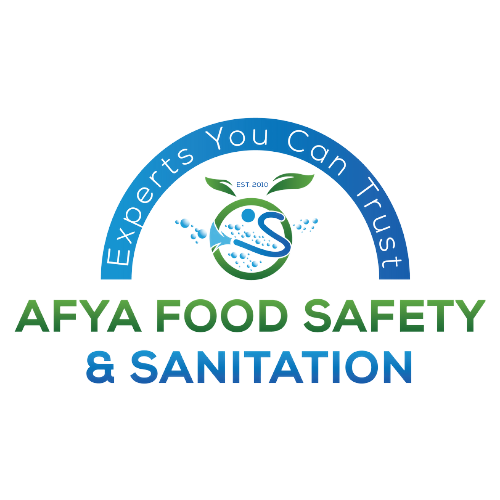
Please Wait For Loading

Please Wait For Loading
Maryland, MD USA
+1 (443) 666-9132
info@afyafoodsafety.com
Opening Hours: 9:00 AM - 5:00 PM
Copyright ©Afya Food Safety all rights reserved.
You can also reach us via Phone: +1 443 666 9132 or via Email:info@afyafoodsafety.com
Basic Elements of Cleaning & Sanitatizing Food Plants
The main building blocks of food safety in food processing operations are cleaning and sanitation (C & S). The key concepts of cleaning and sanitation are knowing what to clean, what soils are present, best practices for cleaning steps & washing factors, and understanding how to handle the chemicals involved safely to maintain a sanitary environment for food processing.
Cleaning is a prerequisite of sanitation. It largely involves the removal of visible and invisible soils and deposits from a surface using appropriate detergent chemicals under specified conditions. The various methods used are clean-in-place (CIP), foaming, clean-out-of-place (COP), spraying, high pressure and manual systems. The Sanitation process is carried out on a cleaned surface to reduce the number of pathogenic microorganisms such as bacteria, viruses, yeasts, and molds to acceptable levels through thermal or chemical means.
A standard sanitation operating procedures (SSOPs) program is written for food contact surfaces (equipments, utensils, etc.), non-product surfaces (overhead structures, shields, walls, ceilings, lighting devices, refrigeration units, and the surroundings to prevent bacterial contamination and cross-contamination in the facility as well as allergen control.
The SSOP’S vary in processing facilities based on; the nature of soils to be removed; the appropriate detergents and cleaning compounds; the contact surface characteristics; Equipment design and plant layout.
The fundamentals of the cleaning and sanitation process are;
Time – This is the recommended length of time required for the surface to be effectively cleaned and sanitized in order to kill microorganisms. The time required is determined by; the equipment size; nature of the soils and thermal degradation of soil on the surface being cleaned; cleaning method.
Action – This is the physical force exerted onto the surface to bring the cleaning compounds into contact with the soils and enhances their removal. This includes use of manual systems such as brushing; foaming; clean-in-place systems; clean-out-of-place systems. Action is exceptionally important with CIP systems. The speed and type of flow through pipes and over surfaces directly affects the efficiency of cleaning.
Concentration – The concentration of the cleaning compound used depends on; the nature of the soils being cleaned; water hardness; the surface being cleaned. The cleaning compounds must be used at the proper concentration recommended by the manufacturer to prevent the chemical compounds from corroding equipments and in the long run lead to less clean ability.
Temperature – Each cleaner has an optimum temperature range at which it should be used. The right temperature is determined by the; Soil characteristics; Processing temperature; the detergent de-foaming point; the condition of soils on the surface being cleaned. This is because the temperature affects their efficacy of the cleaner. The rule of thumb is that cleaning efficacy doubles (up to a point) for every 10°C increase in temperature. High temperatures (above 55°C [131°F]) should be avoided because of the corrosive nature of most chemical sanitizers and cleaning detergents.
Water – The type of cleaning compound that is used in a facility is based on water hardness used in the facility. The use of surfactants in cleaners enhances the ability of water to react with the soils. The water functions to; pre-rinse to remove gross soils; soften soils left on the surface; carry detergent to the surface to be cleaned; carry wastes away from the surface being cleaned; rinse detergent off of the surface; carry sanitizer to the surface after cleaning.
Individual – For an effective cleaning and sanitation program in a food processing plant, staff must be trained and monitored by qualified supervisors and managers to ensure they are following SSOPs. Incorrect cleaning methods and cleaning compounds can spread dirt and bacteria around instead of cleaning it. Training should be ongoing and provided to each new employee; each time there is a new piece of equipment; a new cleaning supply is introduced.
Nature – The products being produced in the facility determine the nature of soils to be removed. The soils are classified as either soluble in water; acid; alkali; water, acid & alkali. The physical condition of the soil deposits affects its solubility properties depending on heat effect, age, dryness and time. Improper use of detergents can actually “set” soils, making them more difficult to remove.
Surface – The type of food contact surface is an important consideration when determining the type of cleaners and practices to use. Typical materials found in processing plants are stainless steel, steel, plastic and tile. This is because are durable, non-porous, food- grade and easily cleanable.
Learn about the various industrial cleaning and sanitation solutions available for your facility.
Sources; Recoveron
Related Posts
Categories
Antibiotic Resistance: A Growing Threat to Food Safety
April 17, 2025Understanding Cross-Contamination: A Major Food Safety Risk
March 31, 2025Calender